Abhishek Arora
News Deja Vu: Connecting Past and Present with Semantic Search
Jun 21, 2024

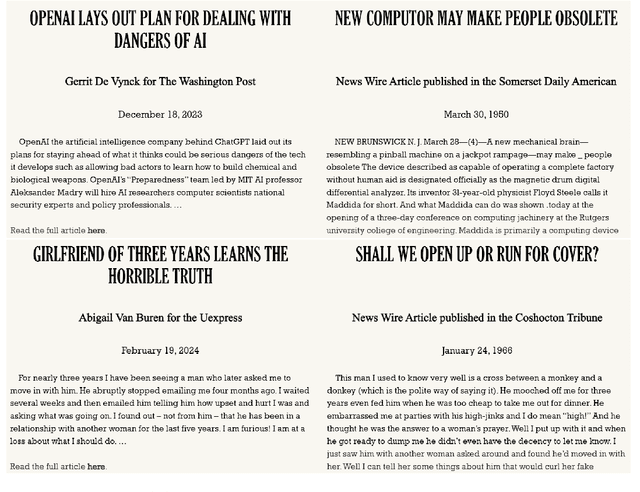

Abstract:Social scientists and the general public often analyze contemporary events by drawing parallels with the past, a process complicated by the vast, noisy, and unstructured nature of historical texts. For example, hundreds of millions of page scans from historical newspapers have been noisily transcribed. Traditional sparse methods for searching for relevant material in these vast corpora, e.g., with keywords, can be brittle given complex vocabularies and OCR noise. This study introduces News Deja Vu, a novel semantic search tool that leverages transformer large language models and a bi-encoder approach to identify historical news articles that are most similar to modern news queries. News Deja Vu first recognizes and masks entities, in order to focus on broader parallels rather than the specific named entities being discussed. Then, a contrastively trained, lightweight bi-encoder retrieves historical articles that are most similar semantically to a modern query, illustrating how phenomena that might seem unique to the present have varied historical precedents. Aimed at social scientists, the user-friendly News Deja Vu package is designed to be accessible for those who lack extensive familiarity with deep learning. It works with large text datasets, and we show how it can be deployed to a massive scale corpus of historical, open-source news articles. While human expertise remains important for drawing deeper insights, News Deja Vu provides a powerful tool for exploring parallels in how people have perceived past and present.
Contrastive Entity Coreference and Disambiguation for Historical Texts
Jun 21, 2024
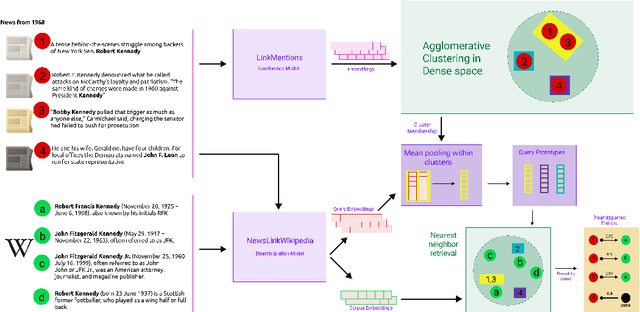
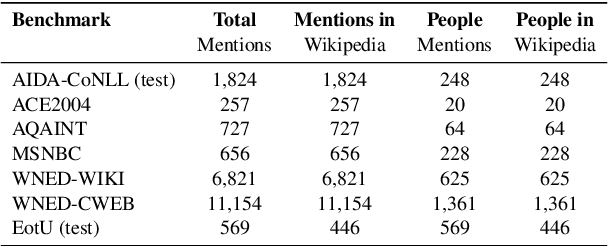

Abstract:Massive-scale historical document collections are crucial for social science research. Despite increasing digitization, these documents typically lack unique cross-document identifiers for individuals mentioned within the texts, as well as individual identifiers from external knowledgebases like Wikipedia/Wikidata. Existing entity disambiguation methods often fall short in accuracy for historical documents, which are replete with individuals not remembered in contemporary knowledgebases. This study makes three key contributions to improve cross-document coreference resolution and disambiguation in historical texts: a massive-scale training dataset replete with hard negatives - that sources over 190 million entity pairs from Wikipedia contexts and disambiguation pages - high-quality evaluation data from hand-labeled historical newswire articles, and trained models evaluated on this historical benchmark. We contrastively train bi-encoder models for coreferencing and disambiguating individuals in historical texts, achieving accurate, scalable performance that identifies out-of-knowledgebase individuals. Our approach significantly surpasses other entity disambiguation models on our historical newswire benchmark. Our models also demonstrate competitive performance on modern entity disambiguation benchmarks, particularly certain news disambiguation datasets.
Newswire: A Large-Scale Structured Database of a Century of Historical News
Jun 13, 2024
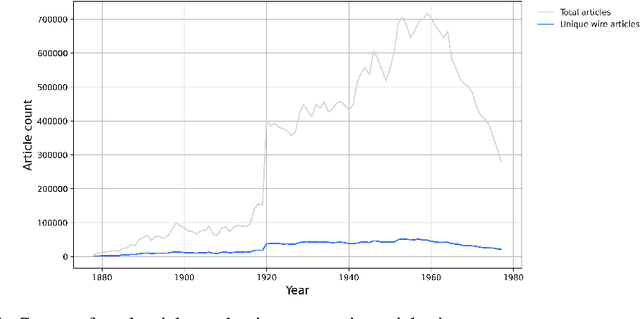
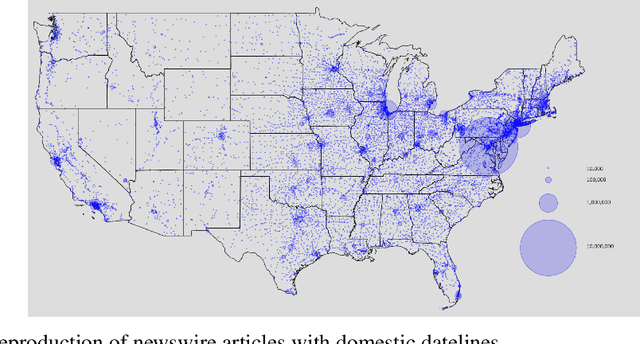
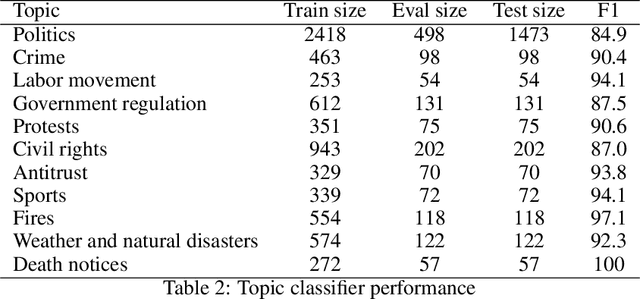
Abstract:In the U.S. historically, local newspapers drew their content largely from newswires like the Associated Press. Historians argue that newswires played a pivotal role in creating a national identity and shared understanding of the world, but there is no comprehensive archive of the content sent over newswires. We reconstruct such an archive by applying a customized deep learning pipeline to hundreds of terabytes of raw image scans from thousands of local newspapers. The resulting dataset contains 2.7 million unique public domain U.S. newswire articles, written between 1878 and 1977. Locations in these articles are georeferenced, topics are tagged using customized neural topic classification, named entities are recognized, and individuals are disambiguated to Wikipedia using a novel entity disambiguation model. To construct the Newswire dataset, we first recognize newspaper layouts and transcribe around 138 millions structured article texts from raw image scans. We then use a customized neural bi-encoder model to de-duplicate reproduced articles, in the presence of considerable abridgement and noise, quantifying how widely each article was reproduced. A text classifier is used to ensure that we only include newswire articles, which historically are in the public domain. The structured data that accompany the texts provide rich information about the who (disambiguated individuals), what (topics), and where (georeferencing) of the news that millions of Americans read over the course of a century. We also include Library of Congress metadata information about the newspapers that ran the articles on their front pages. The Newswire dataset is useful both for large language modeling - expanding training data beyond what is available from modern web texts - and for studying a diversity of questions in computational linguistics, social science, and the digital humanities.
EfficientOCR: An Extensible, Open-Source Package for Efficiently Digitizing World Knowledge
Oct 16, 2023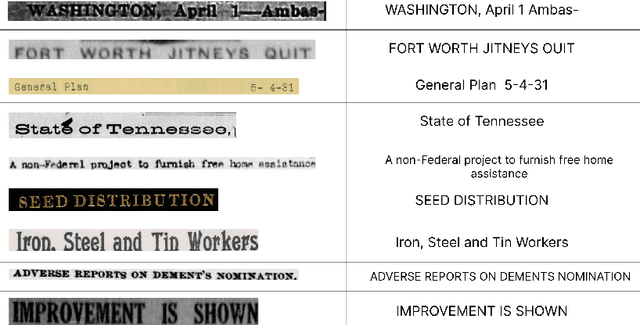
Abstract:Billions of public domain documents remain trapped in hard copy or lack an accurate digitization. Modern natural language processing methods cannot be used to index, retrieve, and summarize their texts; conduct computational textual analyses; or extract information for statistical analyses, and these texts cannot be incorporated into language model training. Given the diversity and sheer quantity of public domain texts, liberating them at scale requires optical character recognition (OCR) that is accurate, extremely cheap to deploy, and sample-efficient to customize to novel collections, languages, and character sets. Existing OCR engines, largely designed for small-scale commercial applications in high resource languages, often fall short of these requirements. EffOCR (EfficientOCR), a novel open-source OCR package, meets both the computational and sample efficiency requirements for liberating texts at scale by abandoning the sequence-to-sequence architecture typically used for OCR, which takes representations from a learned vision model as inputs to a learned language model. Instead, EffOCR models OCR as a character or word-level image retrieval problem. EffOCR is cheap and sample efficient to train, as the model only needs to learn characters' visual appearance and not how they are used in sequence to form language. Models in the EffOCR model zoo can be deployed off-the-shelf with only a few lines of code. Importantly, EffOCR also allows for easy, sample efficient customization with a simple model training interface and minimal labeling requirements due to its sample efficiency. We illustrate the utility of EffOCR by cheaply and accurately digitizing 20 million historical U.S. newspaper scans, evaluating zero-shot performance on randomly selected documents from the U.S. National Archives, and accurately digitizing Japanese documents for which all other OCR solutions failed.
LinkTransformer: A Unified Package for Record Linkage with Transformer Language Models
Sep 02, 2023
Abstract:Linking information across sources is fundamental to a variety of analyses in social science, business, and government. While large language models (LLMs) offer enormous promise for improving record linkage in noisy datasets, in many domains approximate string matching packages in popular softwares such as R and Stata remain predominant. These packages have clean, simple interfaces and can be easily extended to a diversity of languages. Our open-source package LinkTransformer aims to extend the familiarity and ease-of-use of popular string matching methods to deep learning. It is a general purpose package for record linkage with transformer LLMs that treats record linkage as a text retrieval problem. At its core is an off-the-shelf toolkit for applying transformer models to record linkage with four lines of code. LinkTransformer contains a rich repository of pre-trained transformer semantic similarity models for multiple languages and supports easy integration of any transformer language model from Hugging Face or OpenAI. It supports standard functionality such as blocking and linking on multiple noisy fields. LinkTransformer APIs also perform other common text data processing tasks, e.g., aggregation, noisy de-duplication, and translation-free cross-lingual linkage. Importantly, LinkTransformer also contains comprehensive tools for efficient model tuning, to facilitate different levels of customization when off-the-shelf models do not provide the required accuracy. Finally, to promote reusability, reproducibility, and extensibility, LinkTransformer makes it easy for users to contribute their custom-trained models to its model hub. By combining transformer language models with intuitive APIs that will be familiar to many users of popular string matching packages, LinkTransformer aims to democratize the benefits of LLMs among those who may be less familiar with deep learning frameworks.
American Stories: A Large-Scale Structured Text Dataset of Historical U.S. Newspapers
Aug 24, 2023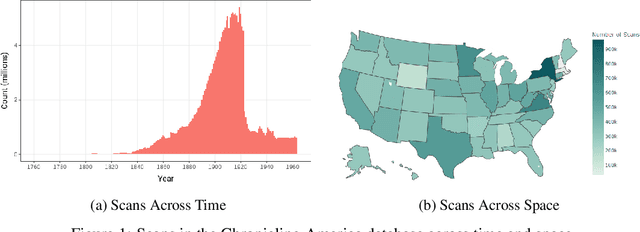

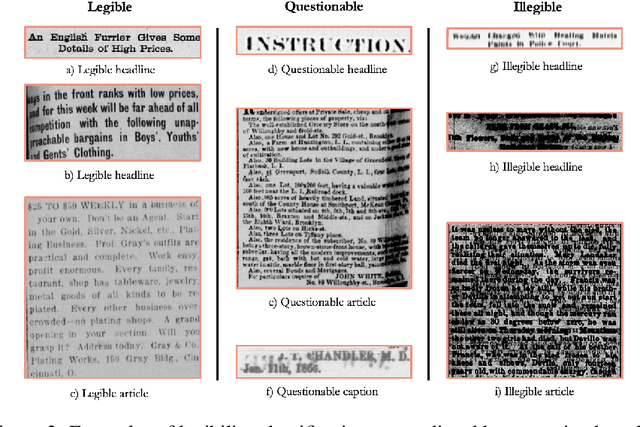

Abstract:Existing full text datasets of U.S. public domain newspapers do not recognize the often complex layouts of newspaper scans, and as a result the digitized content scrambles texts from articles, headlines, captions, advertisements, and other layout regions. OCR quality can also be low. This study develops a novel, deep learning pipeline for extracting full article texts from newspaper images and applies it to the nearly 20 million scans in Library of Congress's public domain Chronicling America collection. The pipeline includes layout detection, legibility classification, custom OCR, and association of article texts spanning multiple bounding boxes. To achieve high scalability, it is built with efficient architectures designed for mobile phones. The resulting American Stories dataset provides high quality data that could be used for pre-training a large language model to achieve better understanding of historical English and historical world knowledge. The dataset could also be added to the external database of a retrieval-augmented language model to make historical information - ranging from interpretations of political events to minutiae about the lives of people's ancestors - more widely accessible. Furthermore, structured article texts facilitate using transformer-based methods for popular social science applications like topic classification, detection of reproduced content, and news story clustering. Finally, American Stories provides a massive silver quality dataset for innovating multimodal layout analysis models and other multimodal applications.
Quantifying Character Similarity with Vision Transformers
May 24, 2023Abstract:Record linkage is a bedrock of quantitative social science, as analyses often require linking data from multiple, noisy sources. Off-the-shelf string matching methods are widely used, as they are straightforward and cheap to implement and scale. Not all character substitutions are equally probable, and for some settings there are widely used handcrafted lists denoting which string substitutions are more likely, that improve the accuracy of string matching. However, such lists do not exist for many settings, skewing research with linked datasets towards a few high-resource contexts that are not representative of the diversity of human societies. This study develops an extensible way to measure character substitution costs for OCR'ed documents, by employing large-scale self-supervised training of vision transformers (ViT) with augmented digital fonts. For each language written with the CJK script, we contrastively learn a metric space where different augmentations of the same character are represented nearby. In this space, homoglyphic characters - those with similar appearance such as ``O'' and ``0'' - have similar vector representations. Using the cosine distance between characters' representations as the substitution cost in an edit distance matching algorithm significantly improves record linkage compared to other widely used string matching methods, as OCR errors tend to be homoglyphic in nature. Homoglyphs can plausibly capture character visual similarity across any script, including low-resource settings. We illustrate this by creating homoglyph sets for 3,000 year old ancient Chinese characters, which are highly pictorial. Fascinatingly, a ViT is able to capture relationships in how different abstract concepts were conceptualized by ancient societies, that have been noted in the archaeological literature.
Linking Representations with Multimodal Contrastive Learning
Apr 11, 2023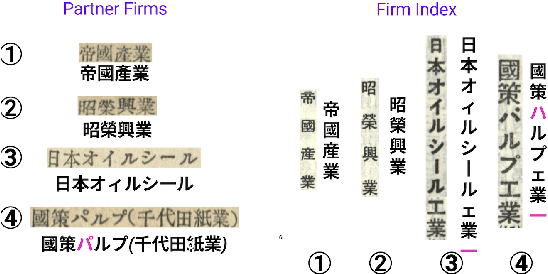
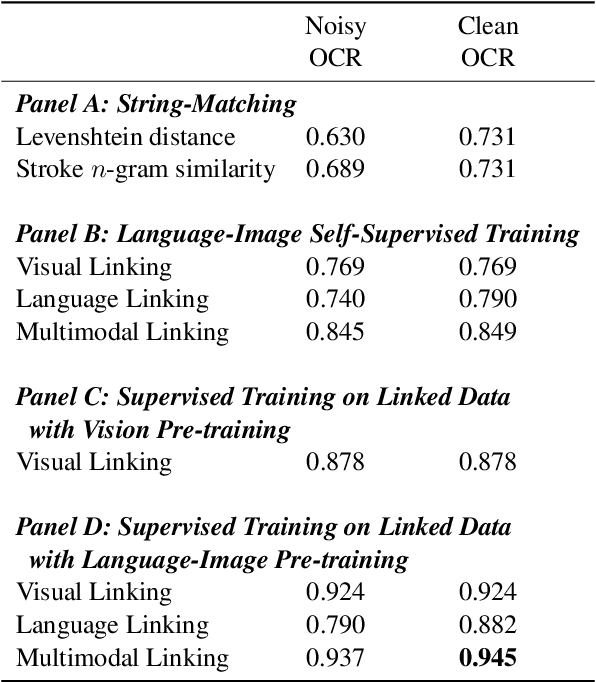

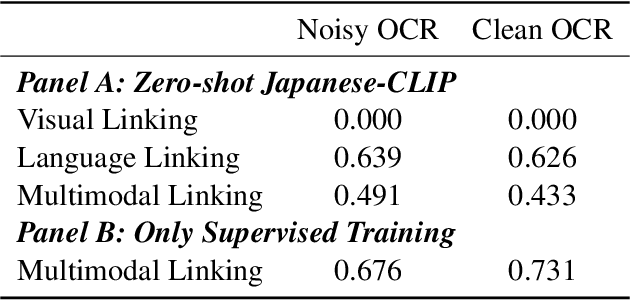
Abstract:Many applications require grouping instances contained in diverse document datasets into classes. Most widely used methods do not employ deep learning and do not exploit the inherently multimodal nature of documents. Notably, record linkage is typically conceptualized as a string-matching problem. This study develops CLIPPINGS, (Contrastively Linking Pooled Pre-trained Embeddings), a multimodal framework for record linkage. CLIPPINGS employs end-to-end training of symmetric vision and language bi-encoders, aligned through contrastive language-image pre-training, to learn a metric space where the pooled image-text representation for a given instance is close to representations in the same class and distant from representations in different classes. At inference time, instances can be linked by retrieving their nearest neighbor from an offline exemplar embedding index or by clustering their representations. The study examines two challenging applications: constructing comprehensive supply chains for mid-20th century Japan through linking firm level financial records - with each firm name represented by its crop in the document image and the corresponding OCR - and detecting which image-caption pairs in a massive corpus of historical U.S. newspapers came from the same underlying photo wire source. CLIPPINGS outperforms widely used string matching methods by a wide margin and also outperforms unimodal methods. Moreover, a purely self-supervised model trained on only image-OCR pairs also outperforms popular string-matching methods without requiring any labels.
 Add to Chrome
Add to Chrome Add to Firefox
Add to Firefox Add to Edge
Add to Edge